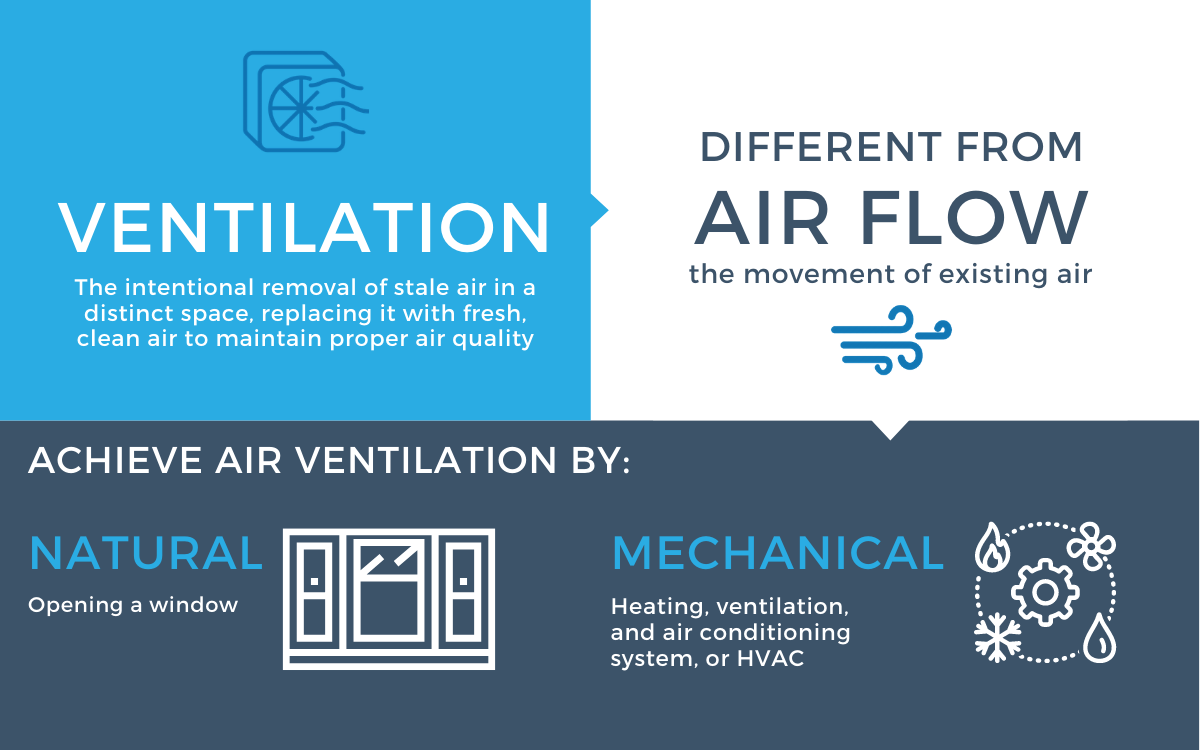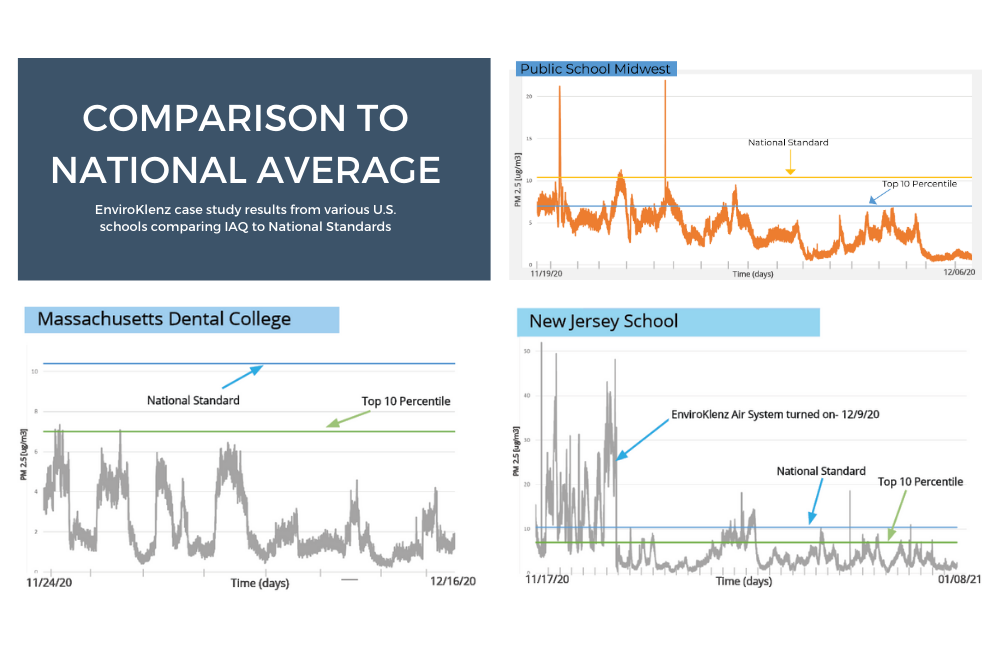Schools across the country have been given new guidelines from the CDC in light of reopening their facilities in the new year. The K-12 Schools COVID-19 Mitigation Toolkit presents a collection of best practices for school officials to assess and implement in order to establish safe, healthy conditions for the returning education community. These guiding measures touch on a wide span of considerations, including pre-screening efforts, in-person operations, mental health and well-being support, and physical cleaning standards; with these suggested approaches follows a major change in how K-12 schools will function in the future.
Ventilation of school facilities is highlighted within these guidelines, as indoor air quality (IAQ) remains highly relevant to healthy classroom conditions due to the airborne risks of COVID-19. Recognizing the importance of proper ventilation and the best actions for improving its quality should be a priority of all schools.
Find out more about how the increased significance of ventilation and IAQ will impact current operations within schools.
Proper Ventilation in the Classroom
The reopening of schools comes with its concern of close contact between students, teachers, and staff. While CDC guidelines of social distancing and frequent sanitation must still be applied to these environments of high interaction, this is not the only means of combating an airborne virus, leading to the relevance of proper ventilation. Aerosol transmission of COVID-19-related respiratory droplets from the cough or sneeze of an infected individuals is one of the ways the virus is spread among people, according to the World Health Organization. An up-to-date, properly maintained HVAC system can reduce airborne transmission of the virus, though the mitigation measures do not end there. Ventilation and air purification can be achieved by various means, some more effective than others, and schools should consider the best methods among these measures for achieving safe and healthy IAQ as they prepare their classrooms.

How HVAC Systems Impact Virus Transmission
As mentioned earlier, proper upkeeping of HVAC systems should reduce airborne transmissions of viruses and pathogens. Maintenance checks and regular filter changes should be a routine measure for HVAC systems in schools who are following the CDC ventilation checklist. Depending on the model and sophistication of the HVAC system, it may benefit from partnering with additional sources of air purification to effectively mitigate airborne pathogens.
Strongly associated with older schools, some potential limitations of an HVAC system stem from the decreased functionality of an outdated or unkept air system. Airborne transmission of the virus is greatly increased in settings of poor ventilation, and without a well-functioning HVAC system, individuals are put at greater risk for infection.
Schools with older or insufficient air units may deal with the risks of:
-
-
- Recirculation of infected air within individual classrooms or the entire school
- Indoor air conditions that support the growth of viruses and bacteria, which can be caused by unregulated humidity and temperature
- Increased potential for asthma and allergies of susceptible individuals due to lack of particulate removal
-
The last thing schools want is for their air systems to be generating risk of virus transmission rather than diminishing it. Studies have shown that ventilation systems have contributed to infectious disease transmission in areas of high risk when factors like low air exchange rates, poor maintenance, and lack of HEPA-grade filters come into play. This indicates concern for how well HVAC systems can reduce COVID-19 transmission if they are not up to standards or not enhanced by other modes of purification. Portable air purifiers for classrooms are a worthwhile consideration for schools preparing safer room conditions, especially in cases of older facilities.
Benefits of Portable Air Systems:
Single room spaces that may have limited access to outdoor air ventilation or receive inadequate ventilation from a central HVAC system could greatly improve their IAQ by means of portable air purifiers. Air purifiers can act as a second layer of protection from airborne pollutants and pathogens, as they can filter the air within a single classroom quickly and more frequently than sole reliance on the HVAC system to do so. They also come in various models that combine the efficiencies of high-grade filtration and UV-C lights to create a combination of defenses.
IAQ Measures to Consider for a Healthy Classroom
In efforts towards better ventilation and reduced risk of airborne virus transmission, it is important to look at the different capabilities and limitations of filtration and purification methods being considered for schools’ IAQ. Filtration of the air differs from ventilation in that it reduces the exposure to contaminants in both indoor and outdoor air by essentially cleaning the air that moves through the filters or filtration system being used. Purification methods add an extra level of deep-cleaning of indoor air.
MERV Filters
Looking at mechanical air filters, they have a porous media of fibers and membrane that catch particulate matter to a certain degree of efficiency, known as the minimum efficiency reporting value (MERV). MERV13 and above are sufficient grades for capturing airborne viruses, as they have been tested to remove size PM1 of particulate matter. The efficiency and effectiveness of MERV13 filters does decrease over time of use, meaning it needs to be changed regularly like any other filter, and its highest-grade filter, MERV16, is not as efficient as a HEPA filter.
HEPA Filters
HEPA, representing high efficiency particulate air, filters are tested as 99.97% efficient for removing 0.3um mass median diameter particulate matter from the air. This grade of filter is used anywhere from hospitals and airplanes to homes and even cars, and it is compatible with many HVAC and portable air systems. For removing viruses and bacterial pathogens, HEPA is more efficient than MERV16 filters. HEPA filtration within HVAC systems can limit any potential spread of airborne viruses that may happen through common air ducts that are shared among rooms or sections of a building; the HEPA acts as essential protection for these possible routes of transmission to remove airborne threats.
UV-C Lights
The ultraviolet energy produced by UV-C lights works to inactivate viruses, bacteria, and fungi at the highest germicidal effect so they cannot reproduce and generate infection. In the form of a lamp, UV-C lights are often paired with other modes of air filtration and purification in order to provide an extended level of germicidal defense, as the lamp alone cannot filter the microorganic matter out of the air. This enhancement is a valid consideration for a school’s existing HVAC system or for additional portable purifiers.
Ionization
The ionization of air is the process of balancing positively and negatively charged ions within the air’s molecular makeup by electrically charging air ions for purification of particulates and contaminants. Air ionizers have been produced for purification efforts, though they come with their controversial limitations, including the inability to remove larger particulates of dust and allergens, emission of ozone, and consequential unfavorable effects on respiratory health. The negative results of ionization portray it as an insufficient mode of achieving proper IAQ due to the potential compromises to health, and this is important to recognize by schools when choosing their mode of air purification.
With context provided for filtration, UV-C lights, and ionization, schools can get a better idea of which modes of air ventilation and purification are best, considering the strengths and weaknesses of each.
Air Purification Systems in Action: Improving School IAQ
EnviroKlenz® conducted a case study involving the effectiveness of using its Air System Plus for particulate matter removal in various classrooms. Referencing EPA national standards for proper air quality, the results revealed that the Air System Plus was able to consistently and effectively bring levels of PM1 and PM2.5 to below the EPA’s maximum acceptable standards of 10ug/m3 of PM2.5, keeping these levels within the top 10 percentile of proper IAQ under the Clean Air Act. The Air System Plus functions using its patented earth-mineral technology within its air cartridge to capture and destroy 99.9% of viruses, bacteria, and other harmful pathogens, further enhanced by HEPA filtration and UV-C lights. Shown by this testing, the use of portable air purifiers is one way of effectively minimizing particulate matter in the air, thus achieving better IAQ over extended periods of use.

Table 1: Case Study Results of Various U.S. Schools; Comparisons of IAQ to National Average
For schools modeling their own efforts for providing safe conditions in the classroom after the CDC’s new guiding toolkit, the use of air purifiers like the Air System Plus may become one of their future measures towards a healthy learning environment. All things considered, school officials will be taking into account the different benefits offered by filtration, ventilation, and purification methods to create the most impactful combination of these for future operations. Thinking in a pandemic-conscious mindset, air quality has a newfound recognition, and this will alter the approaches that education facilities take to keep every member of their community as safe and healthy as possible.
EnviroKlenz® Medical Disclaimer:
“Any information that is provided on this website is not for the use by any commercial or personal entity without expressed written consent of the blog author. The material and statements illustrated within this blog are not intended to diagnose, treat, cure, or prevent any diseases or medical conditions. Nor does the author in any way guarantee or validate the validity, totality, or efficacy of any claims and will therefore not be held responsible for the content of any claims. Always consult your medical physician for any specific medical advice or recommendations.”

